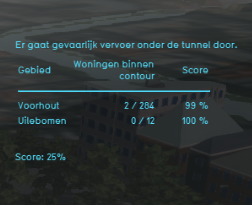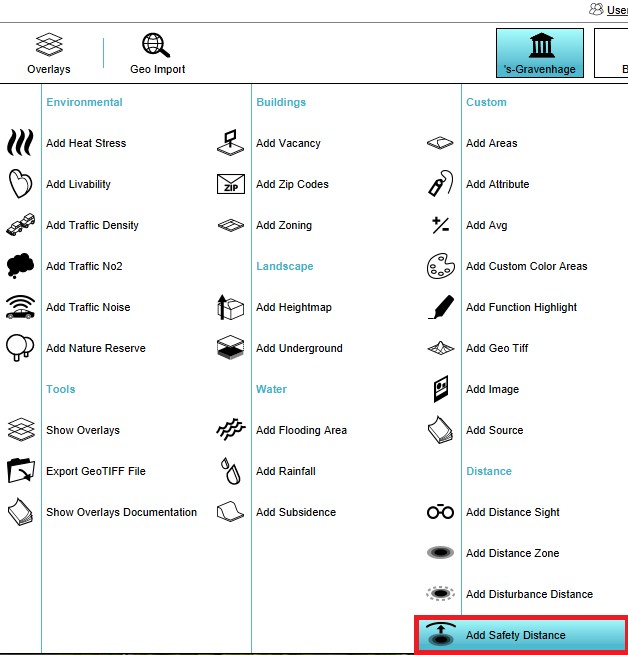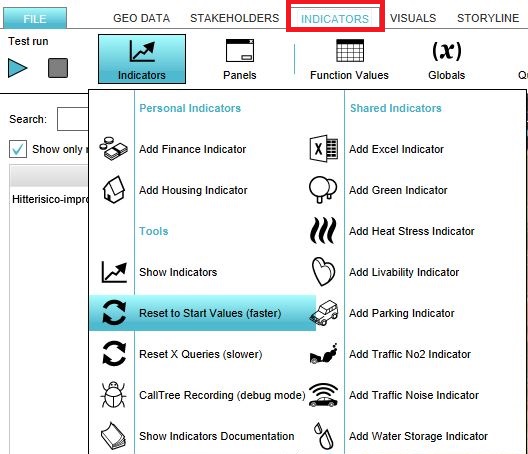Risk contour (Indicator): Difference between revisions
No edit summary |
|||
| Line 5: | Line 5: | ||
The Safety indicator calculates the number of houses that lie in a zone around a hazardous [[Construction]] and the houses that are outside this contour and therefore "safe". The indicatore calculates a risk score per neighborhood based on this ratio. The zones around dangerous constructions come from the [[Safety_Distance_(Overlay)|Safety Distance Overlay]]. This overlay combines information from [[GEO_Data|Risicokaart]] (to know where dangerous hazardous are, for example a LPG station) with a buffer size defined in the [[Functions#Function_values|function values table]] for each dangerous function. | The Safety indicator calculates the number of houses that lie in a zone around a hazardous [[Construction]] and the houses that are outside this contour and therefore "safe". The indicatore calculates a risk score per neighborhood based on this ratio. The zones around dangerous constructions come from the [[Safety_Distance_(Overlay)|Safety Distance Overlay]]. This overlay combines information from [[GEO_Data|Risicokaart]] (to know where dangerous hazardous are, for example a LPG station) with a buffer size defined in the [[Functions#Function_values|function values table]] for each dangerous function. | ||
This indicator is useful for projects in which (for example): | This indicator is useful for projects in which (for example): | ||
* | * Livability is an important aspect of the project | ||
* The project is in an area with a lot of industry | |||
===Indicator panel=== | ===Indicator panel=== | ||
| Line 23: | Line 24: | ||
==Additional configurations== | ==Additional configurations== | ||
For this indicator | For this indicator, the [[Safety_Distance_(Overlay)|Safety Distance Overlay]] has to be added to the project. See below for the steps. | ||
===Add the Safety Distance Overlay=== | ===Add the Safety Distance Overlay=== | ||
Revision as of 10:28, 15 March 2019
General
What is the Safety Indicator?
The Safety indicator calculates the number of houses that lie in a zone around a hazardous Construction and the houses that are outside this contour and therefore "safe". The indicatore calculates a risk score per neighborhood based on this ratio. The zones around dangerous constructions come from the Safety Distance Overlay. This overlay combines information from Risicokaart (to know where dangerous hazardous are, for example a LPG station) with a buffer size defined in the function values table for each dangerous function. This indicator is useful for projects in which (for example):
- Livability is an important aspect of the project
- The project is in an area with a lot of industry
Indicator panel
The indicator panel (see the image on the right) shows in a table per neighborhood:
- the neighborhood name
- the number of houses in the dangerous zone/ total number of houses
- the calculated risk score
Calculation
The risk score is a percentage calculated by firstly retrieving the number of houses in the dangerous zone substracted from the total number of houses in the neighborhood. Then the number of safe houses is divided from the overall number of houses for that neighborhood.
Score
The score is represented in a progress bar, with a scale from 0 to 100%. Determine if you want to calculate the absolute or relative score. The more houses are located in a zone around a dangerous construction, the lower the score. and the more risk there is.
Additional configurations
For this indicator, the Safety Distance Overlay has to be added to the project. See below for the steps.
Add the Safety Distance Overlay
When the indicator is added to the project, an error message can be given. This is due to the missing Safety Distance Overlay in the project. Read below on how to add this overlay to the project.
- Select in the editor 'Geo Data' from the ribbon
- Select 'Overlays' from the ribbon bar
- Select the Safety Distance Overlay from the drop down menu
- Click on the tab Indicators and the button Indicators and choose for Reset to Start values (faster) to update your project.


